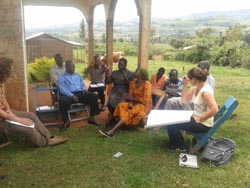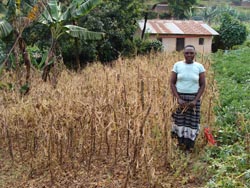The 2015A rainy season is rapidly approaching in Uganda and northern Tanzania. For my PhD research on climbing beans in the highlands of these two countries, we have organized a number of discussions with farmer groups (Figure 1). In these discussions we evaluated the different climbing bean technologies that were demonstrated last season, and the experiences of farmers who tested one of these technologies on their own field. We will use the feedback from these discussions to tailor technologies for the next season. An example is the comment that farmers in Southwestern Uganda made: they prefer the use of shorter stakes because they have seen that the damage caused to flowers and pods by birds is less with shorter stakes. Earlier research has shown, however, that longer stakes give better yields. This is something we are going to assess in the coming season. And it should also give us information on whether farmers who mention staking as a constraint for the cultivation of climbing beans, like the lady on the picture (Figure 2), are better off planting double the area of climbing beans if they cut long stakes in half.
 |
Figure 1 (left): Feedback and planning session with farmers in Eastern Uganda Figure 2: Farmer who mentioned staking as her major constraint for climbing bean cultivation |
 |
Another conclusion from the evaluations with farmers is that farmers do not only look at yield when they evaluate a new technology. In the previous seasons we experimented with different staking methods, such as the use of tripods (three stakes tied together on top) and the use of strings made of sisal or banana fibre. When farmers compared these new methods with single stakes, the common staking method, they mentioned the strength or durability of the method/ material most often as reason for preference of one method over the other (tripods over single stakes and sisal strings over banana fibres). The cost of the staking method was also mentioned more frequently than yield. The evaluations were carried out with separate groups of poorer, medium and wealthier farmers. Farmers with fewer resources preferred staking methods with lower costs and labour demand more often than farmers with more resources (Figure 3). Information like this could help us tailoring technologies to different types of farmers and offering them a ‘basket of options’ to choose from.
|
The evaluations were carried out with separate groups of poorer, medium and wealthier farmers. Farmers with fewer resources preferred staking methods with lower costs and labour demand more often than farmers with more resources (Figure 3). Information like this could help us tailoring technologies to different types of farmers and offering them a ‘basket of options’ to choose from. Figure 3: Reasons that poorer, medium and wealthier farmers gave for preference of one staking method over the other (% is number of times a reason was mentioned divided by the total number of reasons). Staking methods compared were single stakes, tripods, sisal strings and banana fibre ropes. |
 |
Esther Ronner
(Edited since publication on Facebook on 5 February 2015)
